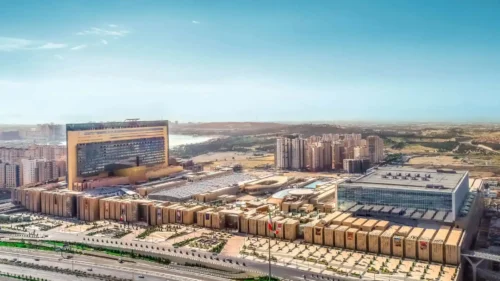
وبلاگ سپهران | iran | Amazing Villages Of Iran
In the amazing villages of Iran, you can experience a different way of life in a serene environment, away from the hustle and bustle of city life.
Tired of urban life and monotony? Looking for a place to rejuvenate and find peace? Do you appreciate pristine nature and the warmth of genuine human connection? Pack your bags and embark on an amazing journey to the villages of Iran. On a trip to the villages of Iran, you will not only enjoy the pristine and captivating nature but also become familiar with the authentic Iranian culture and traditions, experiencing a unique way of life in the heart of nature.
Supporting rural economies and contributing to the sustainable development of villages are among the other advantages of this type of tourism. Iran’s climatic and cultural diversity has turned it into a paradise for rural tourism. From the terraced villages of the north to the desert villages of the south and the mountainous villages in the west and east, every corner of Iran has fascinating villages waiting to be discovered and experienced.
The Rural and Nomadic Tourism Committee of the country has taken a significant step towards the development of this type of tourism by introducing 380 villages as tourist villages. These villages, equipped with suitable amenities, welcome tourists from all over Iran and the world.
Join the Sepehran blog for an exciting journey to the amazing villages of Iran and get acquainted with the pristine beauty, authentic culture, and warm-hearted people of these villages. In this article, discover the best villages in Iran from north to south and from east to west.
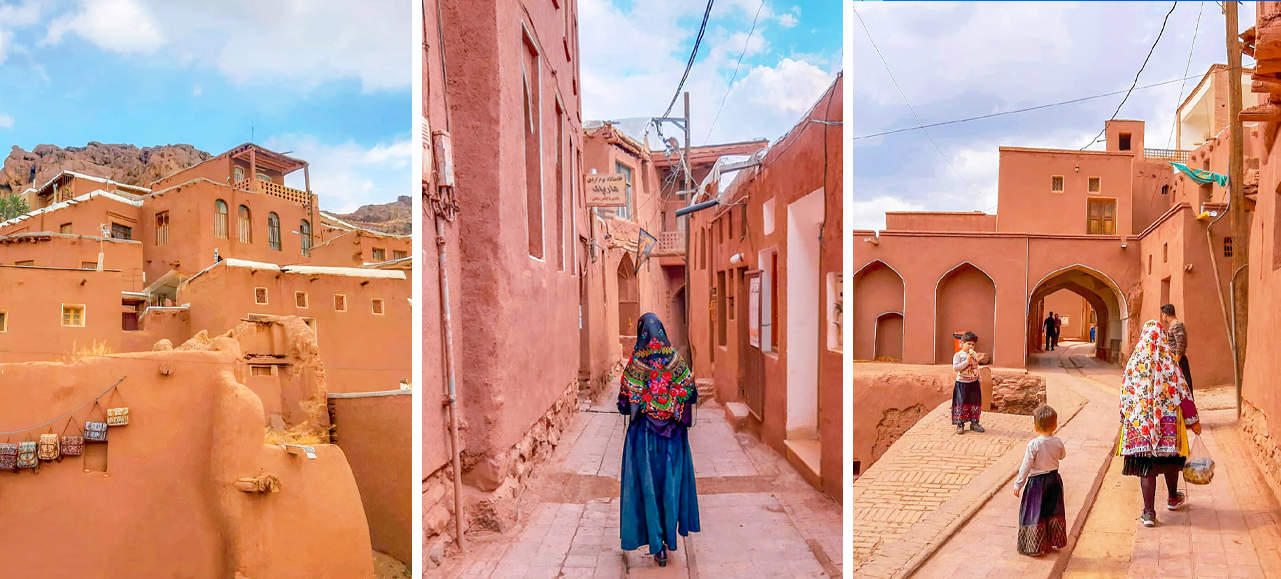
Abyaneh is a village with a history of more than 1500 years located in the Barzrud Valley in the Natanz region. Situated at an altitude of 2160 to 2220 meters above sea level, this village has become one of the most exceptional tourist attractions in Iran due to its unique architecture, traditional lifestyle, and distinctive customs.
Historical evidence indicates that this village has been one of the oldest settlements on the outskirts of the central desert of Iran. The name “Abyaneh ” comes from the word “Viona” or “Viuna,” meaning “willow tree.”
Unique architecture: Abyaneh houses are built with mud bricks and clay, with a reddish hue, and are situated on steep slopes facing the sun.
Customs and traditions: Abyaneh has unique customs, including traditional festivals and special mourning ceremonies.
Due to its natural and cultural attractions, Abyaneh hosts many tourists from all over Iran and the world every year.

The people of the village of Abyaneh speak the ancient Persian language. Some linguists believe that the Abyaneh dialect is an independent language rather than a dialect, which was prevalent in regions such as Natanz, Sime, and Joshaghan Valley, and in some central areas of Iran. However, today, Abyaneh is one of the few places that, due to its distinctive ethnic and cultural characteristics, has preserved its traditions and native culture with minimal influence from other cultures.
The village of Abyaneh, a gem in the heart of the desert, with its unique architecture, captivates every tourist. Walking through the narrow and steep alleys of this village feels like a journey into history.
Compact structure: Houses are closely packed and built on steep mountain slopes.
Indigenous materials: Mud bricks, clay, wood, and stone are the primary materials used in house construction.
Wooden ceilings: House ceilings are covered with wooden beams and thatch.
Variety in construction: Houses are built in different dimensions and shapes.
Wooden porches: Wooden porches are prominent in front of many houses.
Tower and bastion: There are numerous castles and towers in the village.
Abyaneh houses are constructed using stone foundations, adobe and mud brick walls, wooden framing, and wood for doors, windows, and lattices. Wooden porches, known as “sabat,” overlook gardens and alleyways without dead ends and covered passages.
Religious places: Abyaneh has 11 mosques, 2 pilgrimage sites, 2 husseiniyeh (Shia gathering places), and 2 palm groves.
Mosques: Jame Mosque, Porzaleh Mosque, Hajatgah Mosque, Yousemoon Mosque, Palizeh Mosque, Panjeh Ali Mosque, Dam Darvaze Mosque, Chehel Angosht Mosque, Sar Cheshmeh Mosque, and Sar Qanat Mosque.
Pilgrimage Places: 1 pilgrimage site inside the village, 1 pilgrimage site on the main axis of the village, and the famous Abyaneh pilgrimage site in the heart of the mountains.
Sacred Places: The shrine of the princes Yahya and Isa (sons of Imam Musa al-Kadhim) inside the village of Herdeh and the shrine of Bibi Zobeideh Khatoon in the southeast of the village.
Husseiniyehs: 2 husseiniyehs for holding religious ceremonies.
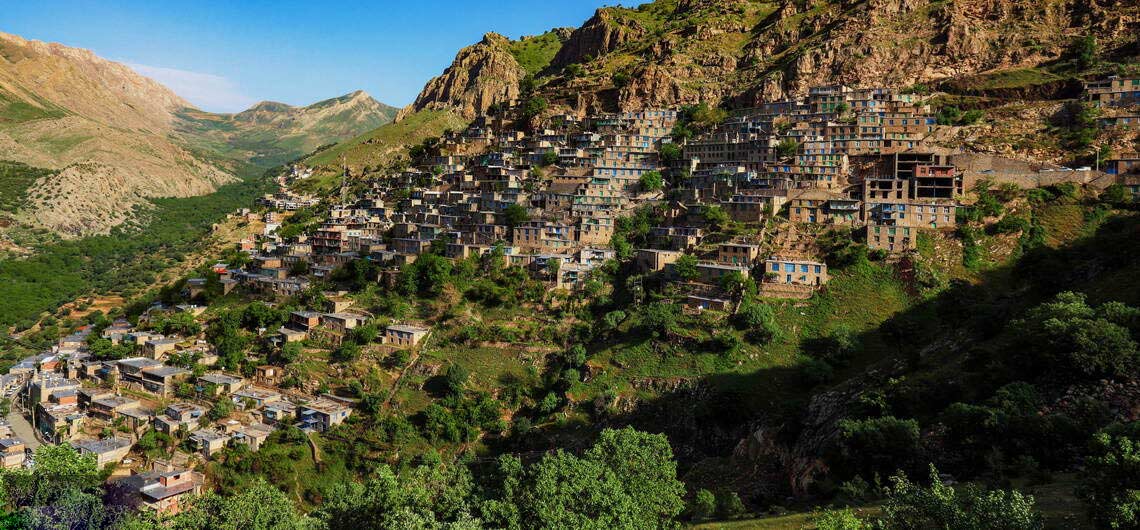
Uraman Takht Village, famous for its “Hezarmasoleh, Kurdistan” in Kurdistan, is nestled 75 kilometers southeast of Marivan, seemingly a gem in the heart of the Alborz Mountains. The history of this terraced village dates back centuries and with its grandeur, it attracts numerous tourists every year.
So, the terraced architecture of Uraman Takht, situated on the mountain slope, mesmerizes every beholder. So, the courtyard of each house serves as the roof of another house, creating an unparalleled view of symmetry and harmony. The use of stone in constructing houses and the absence of mortar have bestowed a unique beauty upon this village.
The word “Uraman” means “house” and “place of Ahura Mazda” in the local language. In the Uraman dialect, “horaman” means a place where clouds come from. Also, “hor” in Avestan means “sun,” hence “horaman” is interpreted as the abode of the sun.
Uraman is considered an ancient land that has been inhabited since the arrival of the Aryans in Iran. Archaeological research indicates that settlement in this area dates back to the Paleolithic period, about 12,000 to 40,000 years ago.
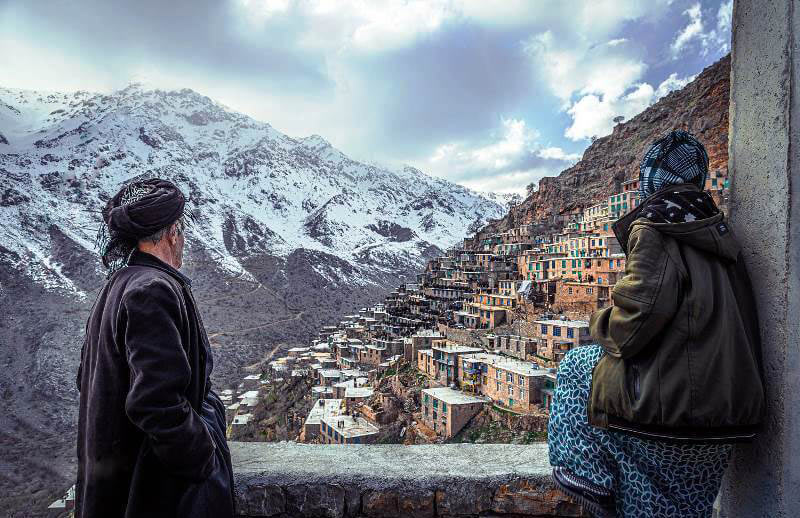
Spring and summer are the best times to visit Uraman Takht. During these seasons, the weather is mild and pleasant, and nature reveals its lush greenery.
For accommodation in Uraman Takht, you can stay in local houses, guesthouses, and eco-lodges.
Hajij Village: With its stepped architecture and stone houses, it evokes an image of Hezarmasoleh.
Garan Bridge: A historic bridge built over the Sirwan River, reminiscent of the Safavid era.
Shalmash falls: A roaring and lofty waterfall that creates a picturesque scene in the heart of lush nature.
Sirwan River: A roaring river flowing alongside the village, bringing freshness and vitality.
A trip to Uraman is incomplete without tasting the local cuisine. The taste of skewered kebab, doogh, almond kernel stew, and local bread will never leave your memory.
This region is one of the special areas in handicrafts. Therefore, the people of Uraman are engaged in weaving and producing items such as felt, trays, wooden spoons and forks, jajim (a type of carpet), matting, baskets, traditional wooden windows, rugs, prayer rugs, rosaries, carpets, various handwoven fabrics, scarf weaving, woolen fabric production, delicate work, wood carving, marquetry, pottery, metalworking, local jewelry, needlework, tassel making, crochet, embroidery, beadwork, black tent weaving, musical instrument making, and more.
So, the inhabitants of Uraman Takht are Sunni Muslims of the Shafei sect who speak “Horami,” which is a branch of the Kurdish language.
The rich and historically significant music of the people of this region, along with the celebration of indigenous and tribal rituals such as the “Helparke” dance and the magnificent ceremony of “Pir Shalyar,” held annually in mid-spring and late winter, has turned “Uraman Takht” into one of the most beautiful and memorable tourist destinations in Iran, attracting a vast number of domestic and foreign tourists.
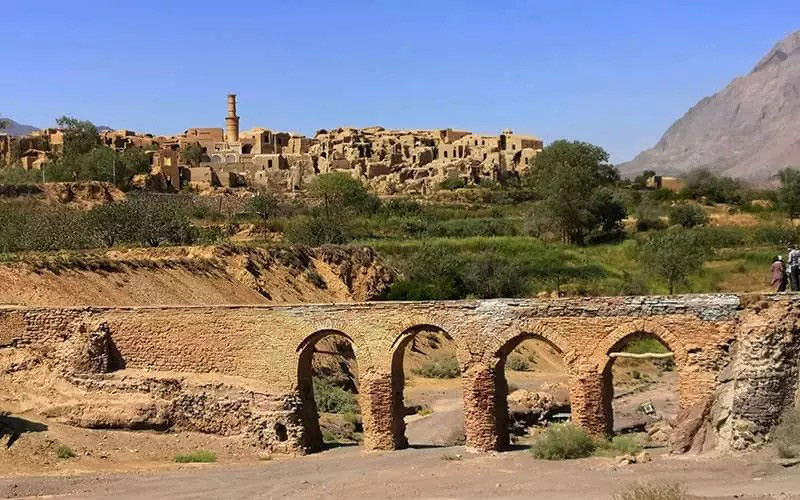
The ancient village of Kharanaq is one of Iran’s fascinating villages, with a history dating back 4500 years, seemingly emerging from the heart of history itself. This astonishing village, formerly known as “Kharanaq,” meaning “birthplace of the sun,” holds many untold secrets within itself.
Kharanaq village is located 85 kilometers from the city of Yazd, along the route from Ardakan to Tabas. Situated atop a hill, this village offers a breathtaking view of the desert.
Kharanaq Fortress is a magnificent structure from the Sasanian era, stand atop a hill along the Ardakan to Tabas road. With an area of 1.1 hectares, this fortress is one of Iran’s largest rural residential fortresses and stands out among the few unique multi-story fortresses worldwide due to its two and three-story houses.
Kharanaq village, due to its ancient history and rich heritage, encompasses numerous tourist attractions. So, Kharanaq features attractions such as the Caravanserai of Mohammad Ali Mirza, historical bathhouse, congregational mosque and hosseinieh, Mashhadak Shrine, Shamsabad Village, Bijneh Cave, and Pir Sabz Chek Chek.
This village has a magnificent structure from the Sasanian era, situated atop a hill at the center of the village. With an area of 1.1 hectares, this fortress stands as one of Iran’s largest rural residential fortresses and is among the few unique fortresses worldwide due to its two and three-story houses. The Caravanserai of Mohammad Ali Mirza, historical bathhouse, congregational mosque, and hosseinieh of Kharanaq, Mashadak Shrine, or “sacred place,” are among its remarkable features.
Camel Neck, Shamsabad Village, Pirghich, Bijneh Cave, and Pir Sabz Chek Chek are among the other tourist attractions of Kharanaq village, each with its own beauty and unique stories.
Another significant part of the village is an aqueduct bridge, considered the oldest water transfer bridge in Yazd Province. This bridge, which has lost its original function due to the drying up of the river, is approximately 40 meters long and about 5.7 meters high.
The primary occupations of Kharanaq’s residents are predominantly agriculture or horticulture, with rare instances of animal husbandry and carpet weaving among its inhabitants. The major products of this village include wheat, carrots (yellow carrots), cotton, barley, and watermelon.
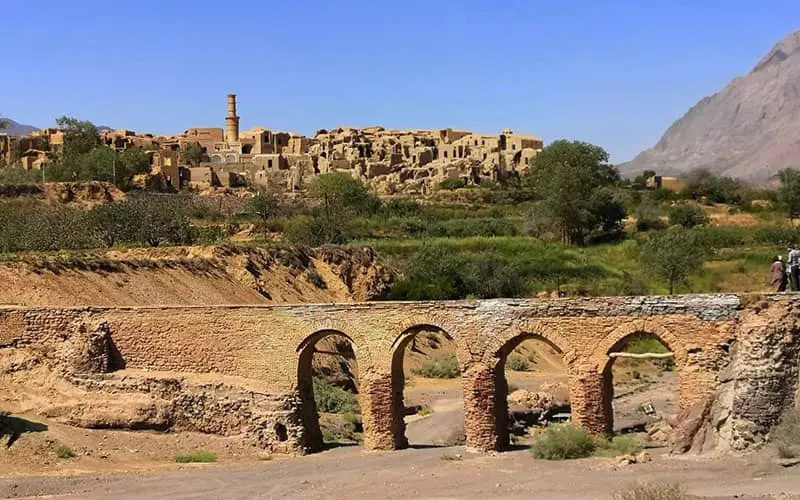
The best time to travel to Kharanaq village is during spring (late March to early June) and autumn (late September to early November). During these times, the weather is mild, avoiding the intense heat of summer and the cold of winter.
From Yazd:
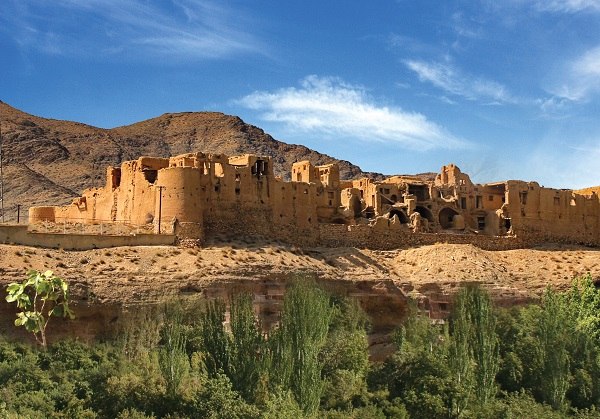
Henjan is a mountainous village located 20 kilometers northwest of Natanz and 150 kilometers from Isfahan. Situated at an altitude of 1560 meters above sea level, this village has a cold and mountainous climate due to the presence of Laviz and Barzqo mountains and the Barzroud and Chimaroud rivers.
In the local dialect, Henjan means “drawing water from a well.” The presence of 9 qanats, a spring, and two rivers in this village is the reason behind its name.
The population of Henjan is less than 500 people. The majority of the people are engaged in agriculture, animal husbandry, and horticulture. Wheat, barley, cotton, corn, apricot, apple, pomegranate, fig, sour cherry, quince, grape, and plum are among the products of this village. Women in Henjan are also engaged in carpet weaving and kilim making.
The old houses in Henjan are made of local materials such as mud, stone, and wood. The small windows and vents in these houses are designed to prevent cold and dry air from entering inside.
The people of Henjan speak a dialect that is a mixture of Persian and Pahlavi languages. The traditional attire of men includes black trousers, shirt, cloak, arkhaliq, waist scarf, and cap, while women wear a velvet hat, charqad, night veil, straight dress, wide trousers, veil, and cap.
Henjan is an ideal destination for nature lovers, history enthusiasts, photographers, and anyone looking for a memorable and unique trip. In this village, you can enjoy the tranquility and silence of nature, immerse yourself in history, get to know warm and friendly people and taste the authenticity of Iranian culture.

Sar Agha Seyed is one of the fascinating villages in Iran, offering a unique experience for tourists with its special architecture, pristine nature, and rich culture. Situated in Masouleh Zagros in Chaharmahal-Bakhtiari Province, 36 kilometers from Kuhrang and 133 kilometers from Shahr-e Kord, this village with its stepped architecture and untouched nature is one of the popular tourist destinations in Iran. The name “Sar Agha Seyed” was given due to the presence of Imamzadeh Seyed Eisa in this village.
Due to its stepped architecture and resemblance to Masouleh Village in northern Iran, Sar Agha Seyed Village is known as “Zagros Masouleh.”
Pristine Nature: Sar Agha Seyed Village is nestled among the Zagros Mountains and has pristine and picturesque nature. Salt springs, Sheikh Ali Khan waterfall, fields of inverted tulips, and mountainous landscapes are among the natural attractions of this village.
Imamzadeh Seyed Eisa: This shrine is located at the bottom of the village and is one of the main reasons for the formation of the village.
Nomads: In spring and summer, Bakhtiari nomads migrate to this area, and you can see their black tents and nomadic lifestyle.
To reach Sar Agha Seyed Village, you can take the Kuhrang-Chelgerd road towards Sheikh Ali Khan Village and then travel 35 kilometers on a dirt road.
Nomadic Festival: This festival is held in spring and includes displays of nomadic customs and traditions, local music, and traditional foods.
Eid al-Adha: The people of Sar Agha Seyed Village celebrate Eid al-Adha with particular enthusiasm and sacrifice sheep and make vows.
Best Time to Visit Sar Agha Seyed Village: The best time to visit Sir Agha Seyed Village is during spring and summer. During these seasons, the weather is moderate, and the nature is lush and beautiful.
Before traveling, check the weather conditions.
Due to the dirt road, drive cautiously.
Respect the culture and customs of the village people.
Avoid littering in nature.
With a trip to Sar Agha Seyed Village, experience a memorable journey amidst the pristine nature of the Zagros Mountains.

Filband, a highland village nestled in the heart of the Eastern Alborz Mountains in Mazandaran Province, is a lost paradise that captivates every traveler with its pristine nature, ocean of clouds, and stunning landscapes.
Imagine walking amidst a sea of clouds at an altitude of 2300 meters, feeling as if you’re standing above the world. This dreamy experience becomes a reality in Filband, the eastern roof of Mazandaran. The cloud ocean of Filband is a remarkable phenomenon that occurs on most days of the year, especially in spring and summer. In this phenomenon, clouds get trapped at lower altitudes, creating a sea-like view of clouds. Walking among these clouds gives you an indescribable sense of freedom and tranquility.
In addition to the cloud ocean, Filband has other tourist attractions, each of which is a reason to visit this highland village:
Pristine and verdant nature: Dense forests, vast plains, and gushing springs have turned Filband into a jewel in the heart of the Alborz Mountains.
Mountainous landscapes: High cliffs and peaks such as Damavand and Alamkuh present breathtaking views before your eyes.
Exciting recreational activities: Mountaineering, rock climbing, and hiking in the forest are among the activities you can enjoy in Filband.
Local cuisine: The delicious taste of local dishes from Amol, such as stuffed chicken, Ki Palau, raisin rice with chicken, and Katteh Amoli, will complete your trip to Filband.
The best time to visit Filband is during spring and summer. During these seasons, the weather is cool, and the cloud ocean displays its beauty. (However, you should be on the lookout for specific times during these months to witness the cloud ocean.) Additionally, Filband in autumn has unique beauty with its myriad colors.
Access Route: To reach Filband, you should take the Haraz Road towards Amol and then move towards the village of Filband through a secondary road.
Accommodation: In Filband, there are various eco-lodges and villas available for rent. Try to reserve accommodation before your trip.
Facilities: This village provides amenities such as restaurants, shops, and a mosque.
Essential Tips: Due to the high altitude of Filband, it’s necessary to bring warm and appropriate clothing. Also, refrain from climbing to high altitudes without proper equipment.
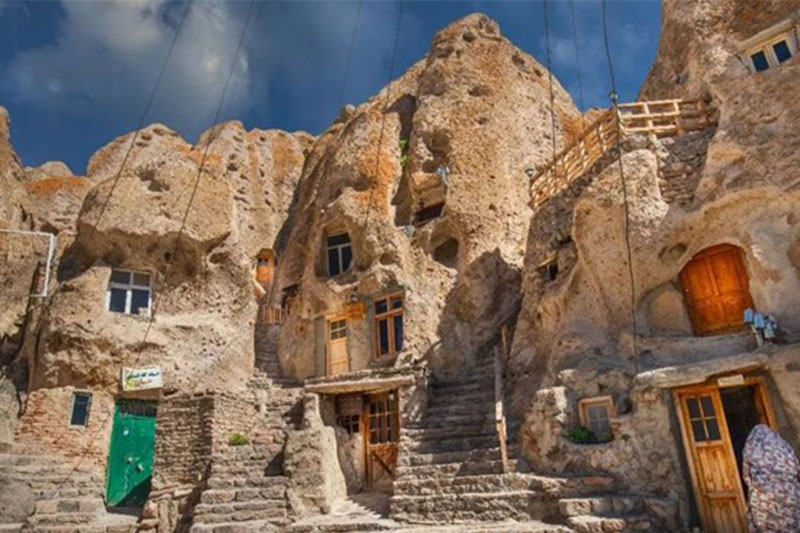
In the northwest of Iran, in East Azerbaijan province, lies a remarkable village called Kandovan. It’s as if this village is a hidden gem nestled in the heart of the Sahand Mountains, revealing its beauty to the world after thousands of years.
With a history dating back 7000 years, Kandovan seems to have emerged from the depths of history and has preserved its resilience and beauty over time. The village is only 18 kilometers away from the city of Osku and shines like a bright gem among the mountains with a population of about 601 people.
The houses of Kandovan are carved into the rocks and are cone-shaped. This type of architecture is unique in the world and exists only in two other villages in Turkey and the United States. The origin of this architecture dates back 700 years, and the reason for it is the use of natural and durable materials against cold and wind.
In addition to its rocky architecture, Kandovan has other tourist attractions:
Virgin and lush nature: The Sahand Mountains, vast plains, and gushing springs have turned Kandovan into a gem in the heart of Azerbaijan.
Mountain landscapes: Tall cliffs and the Sahand peak present stunning views before your eyes.
Exciting recreational activities: Mountaineering, rock climbing, and hiking in the forest are among the activities you can enjoy in Kandovan.
Local cuisine: The delicious taste of Azerbaijani local foods will complete your trip to Kandovan.
Attractive souvenirs: Kandovan honey, walnuts, and handicrafts are among the souvenirs you can purchase from Kandovan.
The best time to visit Kandovan is spring and summer. During these seasons, the weather is cool and pleasant, and nature is lush and vibrant.
We hope by now you have become acquainted with some of the amazing villages in Iran, and if you know of any unrecognized villages in Iran, please send them to us in the comments.